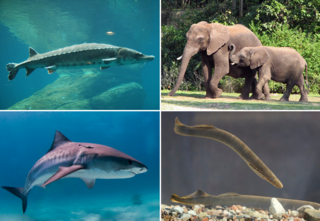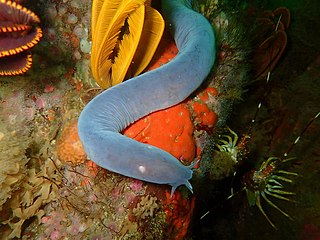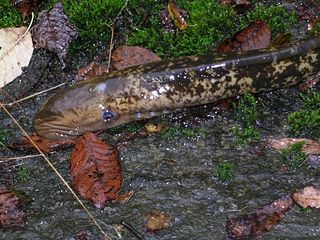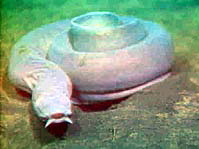
Vertebrates are deuterostomal animals with bony or cartilaginous axial endoskeleton — known as the vertebral column, spine or backbone — around and along the spinal cord, including all fish, amphibians, reptiles, birds and mammals. The vertebrates consist of all the taxa within the subphylum Vertebrata and represent the overwhelming majority of the phylum Chordata, with currently about 69,963 species described.

Hagfish, of the class Myxini and order Myxiniformes, are eel-shaped jawless fish. Hagfish are the only known living animals that have a skull but no vertebral column, although they do have rudimentary vertebrae. Hagfish are marine predators and scavengers who can defend themselves against other larger predators by releasing copious amounts of slime from mucous glands in their skin.

Agnatha is an infraphylum of jawless fish in the phylum Chordata, subphylum Vertebrata, consisting of both living (cyclostomes) and extinct species. Among recent animals, cyclostomes are sister to all vertebrates with jaws, known as gnathostomes.

Arctocephalus forsteri is a species of fur seal found mainly around southern Australia and New Zealand. The name New Zealand fur seal is used by English speakers in New Zealand; kekeno is used in the Māori language. As of 2014, the common name long-nosed fur seal has been proposed for the population of seals inhabiting Australia.

Cyclostomi, often referred to as Cyclostomata, is a group of vertebrates that comprises the living jawless fishes: the lampreys and hagfishes. Both groups have jawless mouths with horny epidermal structures that function as teeth called ceratodontes, and branchial arches that are internally positioned instead of external as in the related jawed fishes. The name Cyclostomi means "round mouths". It was named by Joan Crockford-Beattie.

The broadgilled hagfish or New Zealand hagfish, also known by its Māori language name tuere, is a hagfish found around New Zealand and the Chatham Islands as well as around the south and east coasts of Australia, at depths between 1 and 900 metres.

Hagfish were an American rock band originated in Sherman, Texas that rose to notoriety via performances in the Deep Ellum district of Dallas, Texas, drawing influences from both punk rock and alternative rock. The lineup included lead vocalist George Stroud Reagan III, guitarist Zach Blair, bassist Doni Blair and drummer Tony Barsotti for the majority of the band's career, including nearly all of their recorded work. Formed by the Blair brothers in 1991, Hagfish emerged with contemporaries Tripping Daisy and Toadies as part of the 1990s Dallas/Fort Worth alternative rock scene and were also heavily influenced by the Descendents/All, whose members recorded and produced two of the band's studio albums. After officially disbanding in 2001, Hagfish have reunited occasionally for live performances.

The Pacific hagfish is a species of hagfish. It lives in the mesopelagic to abyssal Pacific ocean, near the ocean floor. It is a jawless fish and has a body plan that resembles early paleozoic fish. They are able to excrete prodigious amounts of slime in self-defense.
Eptatretus strickrotti, commonly known as Strickrott's hagfish, is a hagfish of the genus Eptatretus, found in the depths of the Pacific Ocean south of Easter Island. The hagfish was found in March 2005 by DSV Alvin pilot Bruce Strickrott, and a year later was determined by scientists to be a new species. It is the first hagfish recorded from a hydrothermal vent.

Eptatretus is a large genus of hagfish.

Eels are ray-finned fish belonging to the order Anguilliformes, which consists of eight suborders, 20 families, 164 genera, and about 1000 species. Eels undergo considerable development from the early larval stage to the eventual adult stage and are usually predators.

Myxine is a genus of hagfish, from the Greek μυξῖνος. It is the type genus of the class Myxini.

Myxine glutinosa, known as the Atlantic hagfish in North America, and often simply as the hagfish in Europe, is a species of jawless fish of the genus Myxine.
Nemamyxine is a genus of hagfish.
Neomyxine biniplicata, the slender hagfish, is a species of hagfish endemic to New Zealand. It is known from along the east coast, from the northern end of the Bay of Plenty to Kaikōura at depths of 35–396 m, and is found on silty to coarse sediments and rocky seabeds.
Neomyxine is a genus of hagfish found in the Pacific Ocean around New Zealand.
Rubicundus is a genus of hagfishes, the only member of the subfamily Rubicundinae. All species in it were formerly classified in Eptatretus. R. eos, R. lakeside, and R. rubicundus are known from single specimens caught in the Tasman Sea, Galápagos, and Taiwan, respectively. They are named after the distinctive red coloration that all species share.
Nemamyxine elongata, the bootlace hagfish, is a species of hagfish in the genus Nemamyxine. Distribution, abundance, and natural history are not known. Only two specimens have been collected. One was found dead in a net in the Kaituna River, and thought to have been a fishery discard. The other was collected alive during a trawl at 132-140m in the Canterbury Bight. The larger specimen was 867 mm TL but maximum size is unknown. One specimen was a female with small eggs similar to those of other hagfish species..
The white-headed hagfish is a species of jawless fish of the family Myxinidae (hagfish).
Rubicundus eos, also known as the pink hagfish, is a species of jawless fish in the family Myxinidae.










